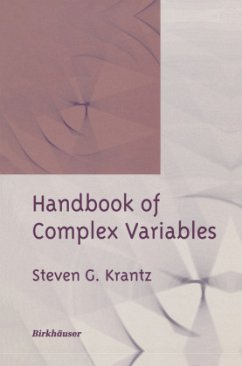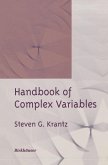This book is written to be a convenient reference for the working scientist, student, or engineer who needs to know and use basic concepts in complex analysis. It is not a book of mathematical theory. It is instead a book of mathematical practice. All the basic ideas of complex analysis, as well as many typical applica tions, are treated. Since we are not developing theory and proofs, we have not been obliged to conform to a strict logical ordering of topics. Instead, topics have been organized for ease of reference, so that cognate topics appear in one place. Required background for reading the text is minimal: a good ground ing in (real variable) calculus will suffice. However, the reader who gets maximum utility from the book will be that reader who has had a course in complex analysis at some time in his life. This book is a handy com pendium of all basic facts about complex variable theory. But it is not a textbook, and a person would be hard put to endeavor to learn the subject by reading this book.
"This modern book can be warmly recommended to mathematicians as well as to users of applied texts in complex analysis; in particular it will be useful to students preparing for an examination in the subject." -Mathematical Reviews
"Creating a 'handbook' such as this is an interesting concept, and to this reviewer's knowledge this is the only one of its type in complex analysis. . . . This book may well be timely and useful to the readers it is intended for: working scientists, students, and engineers . . . The topics contained are quite broad . . . It is noteworthy that a glossary is included that provides the reader with a useful guide to terminology and basic concepts. Other valuable features are: (1) a discussion of the available computer packages that can do some complex analysis such as Maple and Mathematica, (2) a pictorial catalog of conformal well-known maps, and (3) tables of Laplace transforms." -SIAM Review
"Krantz...has two audiences in mind for this handbook: first, the working scientist, with no background in complex analysis, who seeks a specific result to solve a specific problem; and second, the mathematician or scientist who once studied complex analysis and now seeks a compendium of results as an aid to memory. Though Krantz warns that this handbook contains no theory...and thus cannot serve as a textbook, the undergraduate student of complex analysis will nevertheless find certain sections replete with instructive examples (e.g., applications of contour integrations to definite integrals and sums; conformal mapping). Also, the glossary of terminology and notation should offer a useful aid to study.... Students should also see the chapter devoted to surveying computer packages for the study of complex variables. In an undergraduate library, this book can be counted as a supplement to an otherwise strong collection in functions of a single complexvariable." -Choice
"This handbook of complex variables is a comprehensive references work for scientists, students and engineers who need to know and use the basic concepts in complex analysis of one variable. It is not a book of mathematical theory but a book of mathematical practice. All basic ideas of complex analysis and many typical applications are treated. It is also written in a very vivid style and it contains many helpful figures and graphs." ---Zentralblatt MATH
"Creating a 'handbook' such as this is an interesting concept, and to this reviewer's knowledge this is the only one of its type in complex analysis. . . . This book may well be timely and useful to the readers it is intended for: working scientists, students, and engineers . . . The topics contained are quite broad . . . It is noteworthy that a glossary is included that provides the reader with a useful guide to terminology and basic concepts. Other valuable features are: (1) a discussion of the available computer packages that can do some complex analysis such as Maple and Mathematica, (2) a pictorial catalog of conformal well-known maps, and (3) tables of Laplace transforms." -SIAM Review
"Krantz...has two audiences in mind for this handbook: first, the working scientist, with no background in complex analysis, who seeks a specific result to solve a specific problem; and second, the mathematician or scientist who once studied complex analysis and now seeks a compendium of results as an aid to memory. Though Krantz warns that this handbook contains no theory...and thus cannot serve as a textbook, the undergraduate student of complex analysis will nevertheless find certain sections replete with instructive examples (e.g., applications of contour integrations to definite integrals and sums; conformal mapping). Also, the glossary of terminology and notation should offer a useful aid to study.... Students should also see the chapter devoted to surveying computer packages for the study of complex variables. In an undergraduate library, this book can be counted as a supplement to an otherwise strong collection in functions of a single complexvariable." -Choice
"This handbook of complex variables is a comprehensive references work for scientists, students and engineers who need to know and use the basic concepts in complex analysis of one variable. It is not a book of mathematical theory but a book of mathematical practice. All basic ideas of complex analysis and many typical applications are treated. It is also written in a very vivid style and it contains many helpful figures and graphs." ---Zentralblatt MATH









